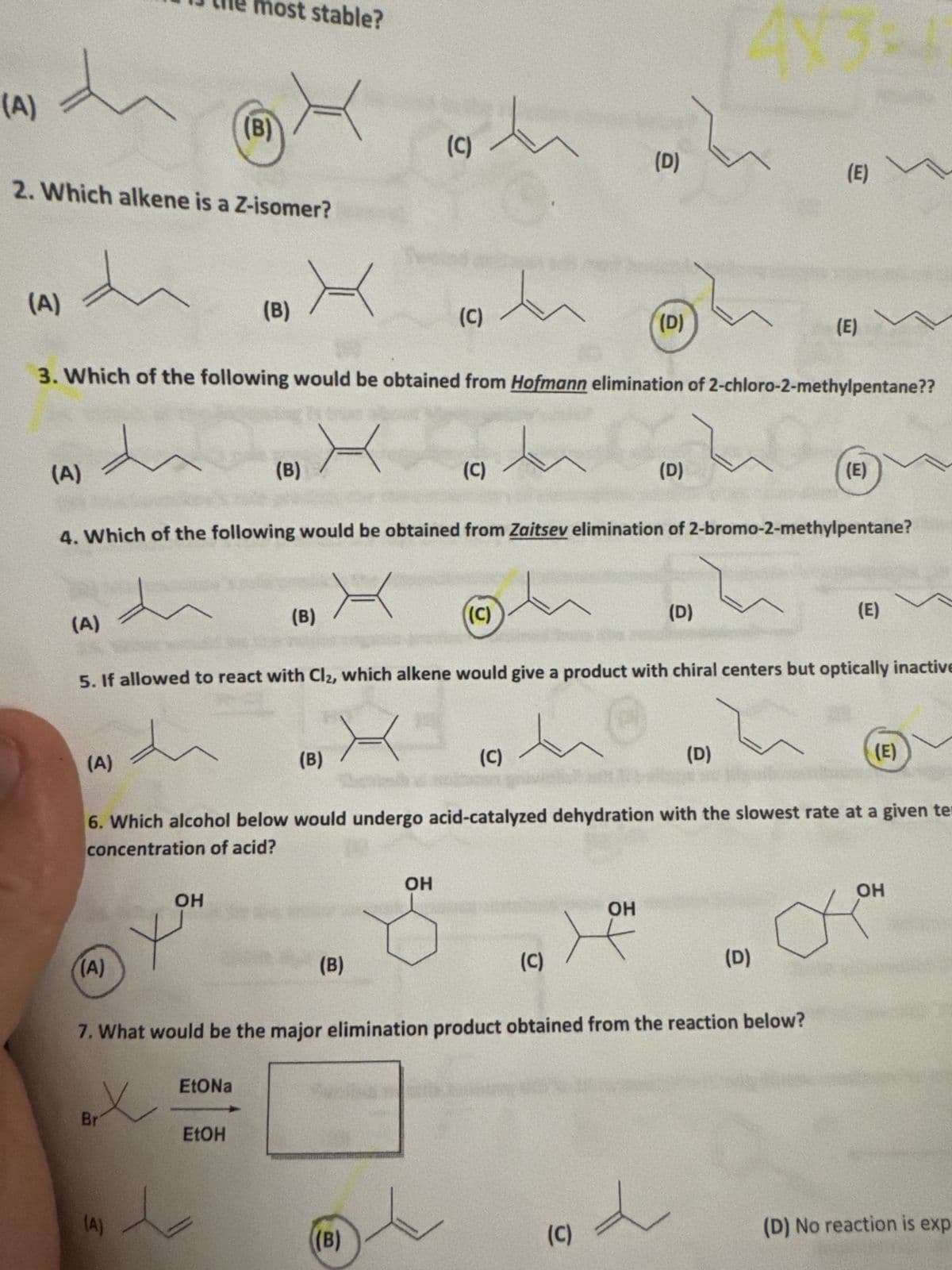(A) the most stable? (B) (c) (D) (E) 2. Which alkene is a Z-isomer? (A) (B) (c) (D) (E) 3. Which of the following would be obtained from Hofmann elimination of 2-chloro-2-methylpentane?? (A) (B) (C) (D) (E) 4. Which of the following would be obtained from Zaitsev elimination of 2-bromo-2-methylpentane? (A) (B) (C) (D) (E) 5. If allowed to react with Cl2, which alkene would give a product with chiral centers but optically inactive (A) (B) (C) (D) (E) 6. Which alcohol below would undergo acid-catalyzed dehydration with the slowest rate at a given te concentration of acid? OH OH (A) (B) OH (C) (D) 7. What would be the major elimination product obtained from the reaction below? EtONa Br X EtOH (A) OH (B) (c) (D) No reaction is exp
(A) the most stable? (B) (c) (D) (E) 2. Which alkene is a Z-isomer? (A) (B) (c) (D) (E) 3. Which of the following would be obtained from Hofmann elimination of 2-chloro-2-methylpentane?? (A) (B) (C) (D) (E) 4. Which of the following would be obtained from Zaitsev elimination of 2-bromo-2-methylpentane? (A) (B) (C) (D) (E) 5. If allowed to react with Cl2, which alkene would give a product with chiral centers but optically inactive (A) (B) (C) (D) (E) 6. Which alcohol below would undergo acid-catalyzed dehydration with the slowest rate at a given te concentration of acid? OH OH (A) (B) OH (C) (D) 7. What would be the major elimination product obtained from the reaction below? EtONa Br X EtOH (A) OH (B) (c) (D) No reaction is exp
Chapter5: Stereochemistry At Tetrahedral Centers
Section5.SE: Something Extra
Problem 70AP
Related questions
Question
Please answer number 3

Transcribed Image Text:(A)
the most stable?
(B)
(c)
(D)
(E)
2. Which alkene is a Z-isomer?
(A)
(B)
(c)
(D)
(E)
3. Which of the following would be obtained from Hofmann elimination of 2-chloro-2-methylpentane??
(A)
(B)
(C)
(D)
(E)
4. Which of the following would be obtained from Zaitsev elimination of 2-bromo-2-methylpentane?
(A)
(B)
(C)
(D)
(E)
5. If allowed to react with Cl2, which alkene would give a product with chiral centers but optically inactive
(A)
(B)
(C)
(D)
(E)
6. Which alcohol below would undergo acid-catalyzed dehydration with the slowest rate at a given te
concentration of acid?
OH
OH
(A)
(B)
OH
(C)
(D)
7. What would be the major elimination product obtained from the reaction below?
EtONa
Br
X
EtOH
(A)
OH
(B)
(c)
(D) No reaction is exp
Expert Solution
This question has been solved!
Explore an expertly crafted, step-by-step solution for a thorough understanding of key concepts.
This is a popular solution!
Trending now
This is a popular solution!
Step by step
Solved in 2 steps with 1 images

Recommended textbooks for you


General, Organic, and Biological Chemistry
Chemistry
ISBN:
9781285853918
Author:
H. Stephen Stoker
Publisher:
Cengage Learning

Organic And Biological Chemistry
Chemistry
ISBN:
9781305081079
Author:
STOKER, H. Stephen (howard Stephen)
Publisher:
Cengage Learning,


General, Organic, and Biological Chemistry
Chemistry
ISBN:
9781285853918
Author:
H. Stephen Stoker
Publisher:
Cengage Learning

Organic And Biological Chemistry
Chemistry
ISBN:
9781305081079
Author:
STOKER, H. Stephen (howard Stephen)
Publisher:
Cengage Learning,